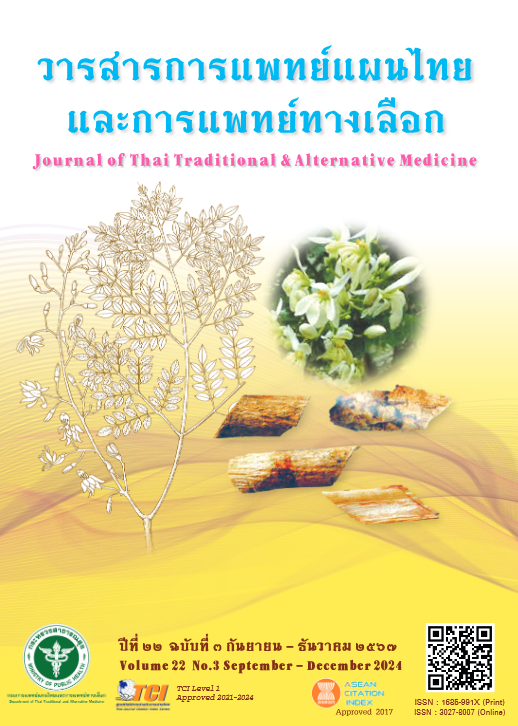Antitumor Activity of Cannabis sativa L. Extract on Liver Cancer in Nude Mice Xenograft Model
Main Article Content
Abstract
Introduction and objective: The most common cancer among Thai people is liver cancer. The use of cannabis botanicals for liver cancer therapies has generated widespread interest. Concerns about efficacy and side effects need to be further investigated.
Methods: Liver cancer (HepG2 cell line) was induced in BALB/c nude mice by subcutaneously injecting 10x106 cells in 100µl into the flank and Tanaosri Kan Daeng cannabis leaf extract (CSRD1) was fed to mice at doses of 1, 5, and 10 mg/kg/day for 24 days. Tumor growth was monitored by measuring with a vernier caliper and in vivo imaging technique.
Results: The study's findings demonstrated a significant reduction in the liver tumor size measured by vernier caliper in the nude mice xenograft model when 10 mg/kg/day of CSRD1 extract was given orally. However, no significant differences were found between the test groups compared to the control group by imaging and analyzing fluorescent signals in experimental animals (in vivo imaging).
Discussion: CSRD1 extract demonstrated a significant reduction in xenograft liver tumor size may be due to the effect of CB1 receptor on intracellular signaling pathways, which inhibits cancer cell migration, cell adhesion, cell proliferation and activates apoptosis. No significant differences were found in fluorescent signals analyzed using in vivo imaging technique due to the limitation of this method caused by tumor hypoxia.
Conclusion and recommendation: CSRD1 extract has shown potential in reducing the size of liver tumors in nude mice xenograft models. Further study is required to investigate its inhibitory effects on metastatic cancer cells. This study could be beneficial in exploring the potential medical applications of cannabis extracts.
Article Details

This work is licensed under a Creative Commons Attribution-NonCommercial-NoDerivatives 4.0 International License.
References
WHO. International Agency for Research on Cancer. [online]. 2020; [cite 2023 Aug 18]; [1
screen], Available from : URL : https://gco.iarc.fr/today/online-analysis-multi-bars
National Cancer Institute. Department of Medical Service, Ministry of Public Health
[Internet]. 2021. [cited 2023 Aug 9]; Available from:
https://www.nci.go.th/e_book/hosbased_2564/index.html (in Thai)
Vogel A, Martinelli E, Vogel A, Cervantes A, Chau I, Daniele B, et al. Updated treatment
recommendations for hepatocellular carcinoma (HCC) from the ESMO Clinical Practice
Guidelines. Ann Oncol. 2021 Jun;32(6):801–5.
Cherkasova V, Wang B, Gerasymchuk M, Fiselier A, Kovalchuk O, Kovalchuk I. Use of
Cannabis and Cannabinoids for Treatment of Cancer. Cancers. 2022 Oct 20;14(20):5142.
Iffland K, Grotenhermen F. An Update on Safety and Side Effects of Cannabidiol: A
Review of Clinical Data and Relevant Animal Studies. Cannabis Cannabinoid Res. 2017
Jan;2(1):139–54.
Hinz B, Ramer R. Cannabinoids as anticancer drugs: current status of preclinical research.
Br J Cancer. 2022 Jul 1;127(1):1–13.
Radapong S, Suppajariyawat P, Sahad T, Harnkit N, Phankhajon K, Primprai P, Banyati P,
Chaisomboonpan S, Sincharoenpokai P, Ritchie KJ. Investigation of the Cytotoxicity of
Thai Cannabis Extracts on Various Cancer Cell Lines. Bull Dept Med Sci. 2021; 63(3): 456-
(in Thai)
Shangguan F, Zhou H, Ma N, Wu S, Huang H, Jin G, et al. A Novel Mechanism of
Cannabidiol in Suppressing Hepatocellular Carcinoma by Inducing GSDME Dependent
Pyroptosis. Front Cell Dev Biol. 2021 Jul 19;9:697832.
Kis B, Ifrim FC, Buda V, Avram S, Pavel IZ, Antal D, et al. Cannabidiol—from Plant to
Human Body: A Promising Bioactive Molecule with Multi-Target Effects in Cancer. Int J
Mol Sci. 2019 Nov 25;20(23):5905.
Hosami F, Ghadimkhah MH, Salimi V, Ghorbanhosseini SS, Tavakoli-Yaraki M. The
strengths and limits of cannabinoids and their receptors in cancer: Insights into the role
of tumorigenesis-underlying mechanisms and therapeutic aspects. Biomed
Pharmacother. 2021 Dec;144:112279.
Choy G, Choyke P, Libutti SK. Current Advances in Molecular Imaging: Noninvasive in
Vivo Bioluminescent and Fluorescent Optical Imaging in Cancer Research. 2003;2(4).
Puaux AL, Ong LC, Jin Y, Teh I, Hong M, Chow PKH, et al. A Comparison of Imaging
Techniques to Monitor Tumor Growth and Cancer Progression in Living Animals. Int J
Mol Imaging. 2011 Nov 10;2011:1–12.
Daimiel I. Insights into Hypoxia: Non-invasive Assessment through Imaging Modalities and
Its Application in Breast Cancer. J Breast Cancer. 2019;22(2):155.
Wiley JL, Burston JJ, Leggett DC, Alekseeva OO, Razdan RK, Mahadevan A, et al. CB 1
cannabinoid receptor-mediated modulation of food intake in mice: CB 1 modulation of
food intake. Br J Pharmacol. 2005 Jun;145(3):293–300.
Suk KT, Mederacke I, Gwak GY, Cho SW, Adeyemi A, Friedman R, et al. Opposite roles of
cannabinoid receptors 1 and 2 in hepatocarcinogenesis. Gut. 2016 Oct;65(10):1721–32.
Cluny NL, Keenan CM, Reimer RA, Le Foll B, Sharkey KA. Prevention of Diet-Induced
Obesity Effects on Body Weight and Gut Microbiota in Mice Treated Chronically with Δ9-
Tetrahydrocannabinol. Bartolomucci A, editor. PLOS ONE. 2015 Dec 3;10(12):e0144270.
Santos NP, Colaço AA, Oliveira PA. Animal models as a tool in hepatocellular carcinoma
research: A Review. Tumor Biol. 2017 Mar;39(3):101042831769592.
Jung J. Human Tumor Xenograft Models for Preclinical Assessment of Anticancer Drug
Development. Toxicol Res. 2014 Mar 31;30(1):1–5.


